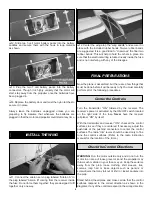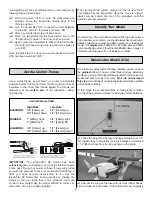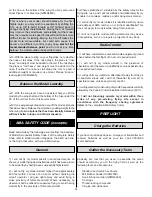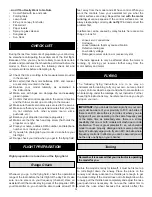
re-programmed. This is something that you can easily do by
following these simple steps:
❏
1. With the power “OFF” to both the transmitter and
airplane, move the transmitter throttle stick to full
throttle position.
❏
2. Turn the transmitter “ON,” connect the motor batteries
to the ESC, and turn the plane’s receiver “ON.”
❏
3. After 5 seconds the motor will beep once.
❏
4. Move the transmitter throttle stick toward you to the
“throttle down” position. The motor will beep once.
❏
5. Again, move the transmitter throttle stick to full throttle,
the motor will beep once more to confirm the brake is
now “OFF.”
Once the brake is set, it does not require resetting once the
ESC has been switched “OFF.”
Use a Great Planes Accu-Throw
™
or a ruler to accurately
measure and set the control throw of each control surface as
indicated in the chart that follows. Note: The throws are
measured at the widest part of the elevators, rudder,
and ailerons.
IMPORTANT: The ElectriStar EP Select has been
extensively flown and tested to arrive at the throws at which
it flies best. Flying your model at these throws will provide
you with the greatest chance for successful first flights. If,
after you have become accustomed to the way the
ElectriStar EP Select flies and would like to change the
throws to suit your taste, that is fine. However, too much
control throw could make the model difficult to control, so
remember, “more is not always better.”
When turning off the system, always turn the receiver “OFF”
first, followed by the transmitter. Once the motor is “armed”
always remain behind the arc of the propellers until the
batteries are disconnected.
No matter if you fly at an AMA sanctioned R/C club site or if you
fly somewhere on your own, you should always have your name,
address, telephone number, and AMA number on or inside your
model. It is required at all AMA R/C club flying sites and AMA
sanctioned flying events. Fill out the identification tag on page 14
of this manual and place it on or inside your model.
More than any other factor, the C.G. (balance point) can have
the greatest effect on how a model flies and may determine
whether or not your first flight will be successful. If you value this
model and wish to enjoy it for many flights, do not disregard
this step. A model that is not properly balanced will be unstable
and possibly unflyable.
At this stage the model should be in ready-to-fly condition
with all of the systems in place including the motor batteries.
❏
1. Take the wing off of the fuse and use a felt-tip pen or 1/8"
[3mm]-wide tape to accurately mark the balance point located
3-1/2" [89mm] back from the LE as shown in the photo.
❏
2. Mount the wing on the fuse with just four rubber bands.
Lift the model on both sides of the model with your fingertips
Balance the Model (C.G.)
Identify Your Model
Control Throws Chart
High Rate
Low Rate
ELEVATOR:
5/8" [16mm] up
3/8" [9.5mm] up
5/8" [16mm] down
3/8" [9.5mm] down
RUDDER:
1" [25mm] right
3/4" [19mm] right
1" [25mm] left
3/4" [19mm] left
AILERONS:
3/8" [9.5mm] up
1/4" [6.4mm] up
3/8" [9.5mm] down
1/4" [6.4mm] down
Set the Control Throws
11
















